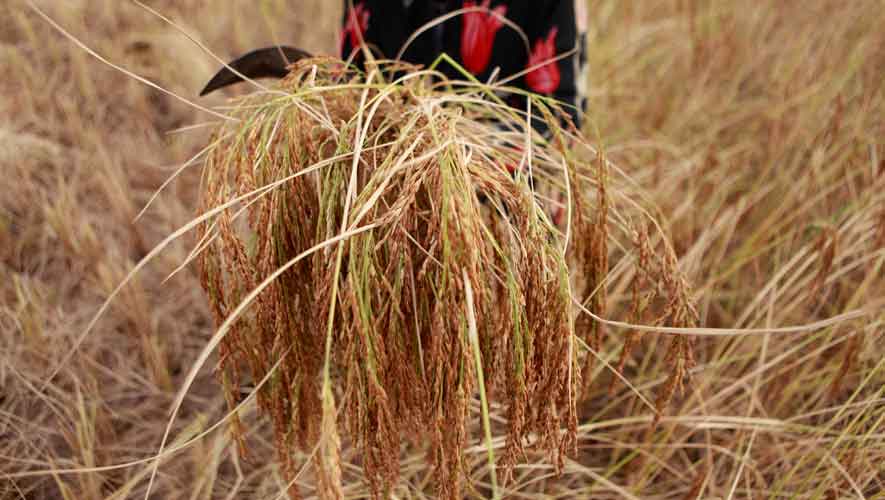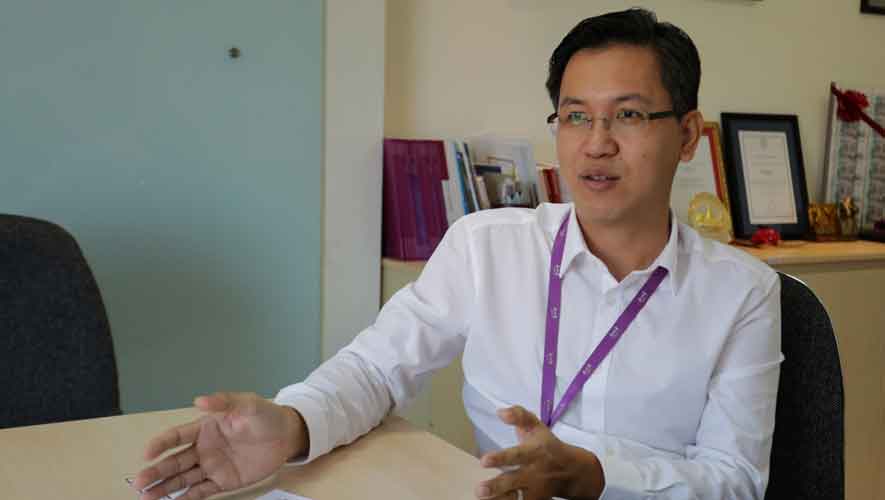Shortly after the EU rice tariff imposition, rice farmers have to face climate risks and rising debt
For the latest Cambodian Business news, visit Khmer Times Business
Already reeling from numerous blows including the fall in global rice price, the imposition of safeguards by the European Union, and occasional floods, the rice sector now has to contend with another blow – rising temperatures.
From April to May, the Kingdom is expected to feel temperatures of between 40 and 42 degrees Celcius, and thunderstoms with strong winds due to the El Nino phenomenon.
Cambodia is home to some three million rice farmers, who make up 19 percent of the population, and paddy fields spread over an area of 2.91 million hectares.
United Nations Development Programme (UNDP) says in a report that severe droughts are not peculiar to Cambodia. In 2015, farmers experienced the worst drought in half a century when some 2.5 million hectares of land in most of the 25 rice-planting provinces faced water shortage.
UNDP says that severe drought during one rice producing season can result in the loss of over 80 percent of the potential harvest.
With the impending drought, largely indebted farmers with loans from microfinance institutions (MFIs) have been told not to grow the crop’s second cycle from March to May due to water shortage.
Farmer Mot Sovan Mony from Kampong Cham’s Bantheay district, who works on two hectares of land, is harvesting his Indica rice variety crop planted in November last year.
He says the price of the variety has dropped this season compared to last year.
“The price of Indica rice is between 650 riel and 700 riel per kilogram versus 850 riel last year. I can get a yield of four to five tonnes per hectare,” he tells Capital Cambodia.
Provincial agriculture officials have been asked to closely monitor the situation and guide farmers to plant the weather-resilient crops, Agriculture Ministry spokesman Srey Vuthy says.
During the dry season, there are more than 500,000 hectares of paddy land in the country which is planted with the Indica rice variety that takes three months to mature.
“The departments need to reserve seeds, fertiliser and other facilities to help the farmers. We will support the farmers through this difficult period whether it is hit by floods or drought.
“When there are (weather) problems, we intervene immediately to dispense reserved fertilisers, pesticides, and seedling to help farmers. (For now) we have advised farmers not to grow rice for the second dry season in March to May,” Vuthy adds.

He says the government understands that there would be an impact on farmers’ livelihood as they usually plant twice a year.
In some areas, farmers are starting to plant the second round of paddy cycle but they are not recommended to do it as it would result in losses due to an impending water shortage.
“Therefore, we encourage them to find alternative income such as raising livestock or planting vegetables and other crops that are resilient to drought,” Vuthy adds.
Mony says farmers are already earning less than last year’s dry season because of the $500 production cost and the situation is further compounded by the loss of income from the second crop planting.
“We want to plant the second cycle this dry season but we are not allowed as there is not enough water to irrigate the crop. The water is needed for daily consumption. Our livelihood is badly affected by the weather,” he added.
Worse, most farmers in his commune are swollen with debts following the loss of income and inability to service the interest rates of their microfinance loans.
“The loans were taken to lease paddy fields from landowners to grow rice,” he says, adding that volatility of the price of rice also impacts their income.
According to the FOB (Free on Board) price index, milled rice dipped between Jan 16 and Feb 13, 2019.
In that period, Cambodia’s five percent broken white rice fell 6.45 percent to $435 per tonne from $465 per tonne, and 10 percent broken white rice slipped 6.52 percent to $430 per tonne from $460. As for 25 percent broken white rice, the price dropped 7.78 percent to $415 from $450 per tonne while Cambodian Jasmine rice stayed stable at $970 per tonne.
On the debt side, Cambodia Microfinance Association president Kea Borann says farmers usually borrow late April to plant rice.
However, if the drought is prolonged till May or June, the loan on the agriculture sector would reduce.
Borann, who is also AMK Microfinance Institution chief executive officer, says financial institutions will not force farmers to pay back if they lose their production and yield due to the climate change or natural disasters.

“We will handle it on a case by case basis. We have a soft policy to protect customers. We grow when customers grow. Therefore, we will find solutions for them if they can’t repay the loan on time due to natural disasters,” Borann adds.
Sixty-five percent of AMK’s loan portfolio consists of the agriculture sector, Borann says, adding that loans range between $700 and $2,500 per farmer.
“It is good that the people have been advised on climate change. Generally, it depends on the crops. If they cannot grow rice from March to May, they can choose to grow other crops like bean.
“The drought this year is not the first. Risk in the agriculture loan sector is not just related to rain or drought. It also emanates from market forces and disease. So, it is a high risk sector compared to others,” he adds.
Forte Micro Insurance Plc is reserving up $700,000 to compensate clients who work on more than 2,000 hectares of land, this year.
The compensation is high due to the prolonged dry spell, general manager Ny Lyhoung says.
It plans to start selling crop insurance products to farmers in March or April so they can be protected.
Last year, 100 customers from Banteay Meanchey, Battambang, Pursat, Siem Reap and Kampong Thom received a total of $7,000 compensation. CapCam
Sok Chan
Business Writer, Capital Cambodia




